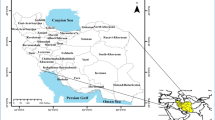Abstract
By combining the concepts of environmental stress, state susceptibility and environmental crisis, “Security Diagram” (SD) provides a quantitative approach to assessing environmental change and human security. The SD is a tool that clearly presents in a diagram the security situation of a population or region affected by a particular environmental crisis. Its underlying concept emphasises that the higher the level of environmental stress and socio-economic susceptibility, the higher the probability of the occurrence of crisis. Focusing on drought, this study analyses the susceptibility of case study regions in India, Portugal, and Russia from a socio-economic perspective. A conceptual framework of socio-economic susceptibility is developed based on the economic development theories of modernisation and dependency. Fuzzy set theory is used to generate susceptibility indices from a range of national and sub-national indicators, including financial resources, agricultural dependency and infrastructure development (for economic susceptibility), and health condition, educational attainment and gender inequality (for social susceptibility). Results indicate that socio-economic susceptibility over the period 1980–1995 was highest in India, followed by Russia and (since 1989) lowest in Portugal. Globalisation is likely to contribute to changes in the level of socio-economic susceptibility over time. Moreover, specific social and economic structures unique in each country (e.g., the role of women in society in India, the socialist legacy in Russia) may explain differences in susceptibility between the case study regions.






Similar content being viewed by others
References
Acosta-Michlik L (2005) Intervulnerability Assessment: Shifting Foci from Generic Indices to Adaptive Agents in Assessing Vulnerability to Global Environmental Change (A Pilot Project in the Philippines). Project Report of the Advanced Institute on Vulnerability to Global Environmental Change. http://www.start.org/Program/advanced_institutes_3.html
Acosta-Michlik L, Eierdanz F, Alcamo J, Klein RJT, Kumar K, Campe S (2006) How vulnerable is India to climatic stress? Measuring vulnerability to drought using the security diagram concept. Climate Change and Human Security. DIE ERDE Special Volume Clim Change 137(1):223–252
Acosta-Michlik L, Rounsevell M (2008). An agent-based framework for assessing vulnerability futures. In: Schröter D, Patt AG, de la Vega-Leinert AC, Klein RJT (eds) Environmental vulnerability assessment for policy and decision-making. Earthscan (in press)
Alcamo J, Endejan M (2001) The security diagram: an approach to quantifying global environmental security. In: Petzold-Bradley E, Carius A, Vincze A (eds) Responding to environmental conflicts: implications for theory and practice. Kluwer, Netherlands
Blaikie T, Cannon ID, Wisner B (1994) At risk: natural hazards, people’s vulnerability and disasters. Routledge, London
Bohle HG, Downing TE, Watts MJ (1994) Climate change and social vulnerability: toward a sociology and geography of food insecurity. Glob Environ Change 4(1):37–48. doi:10.1016/0959-3780(94)90020-5
Bonvillain N (2001) Women and men: cultural constructs of gender. Prentice-Hall, Inc., Upper Saddle River
Caldwell JC (1993) Health transition: cultural, social and behavioral determinants of health in the Third World. Social Sci Med 36:125–135
Cornelissen AMG, Berg JVD, Koops WJ, Grossman M, Udo HMJ (2001) Assessment of the contribution of sustainability indicators to sustainable development: a novel approach using fuzzy set theory. Agric Ecosyst Environ 86:173–185. doi:10.1016/S0167-8809(00)00272-3
Downing TE, Butterfield R, Cohen S, Huq S, Moss R, Rahman A et al (2001) Vulnerability indices: climate change impacts and adaptation. UNEP, Nairobi
Dunlop JE, Velkoff VA (1999) Women of the world: Women and the economy in India.WID/98–2, U.S. Department of Commerce, Bureau of Census, 7 pp
Eierdanz F, Alcamo J, Acosta-Michlik L, Krömker D, Tänzler D (2008) Using fuzzy set theory to address the uncertainty of susceptibility to drought. Reg Environ Change (this volume)
Gavrilova NS, Semyonova VG, Evdokushkina GN, Gavrilova LA (2000) The response of violent mortality to economic crisis in Russia. Popul Res Policy Rev 19:397–419. doi:10.1023/A:1010621601409
Gupta S, Verhoeven M, Tiongson ER (2002) The effectiveness of government spending on education and health care in developing and transition economies. Eur J Polit Econ 18:717–737. doi:10.1016/S0176-2680(02)00116-7
Homer-Dixon TF (1994) Environmental scarcities and violent conflict: evidence from cases. Int Secur 19(1):5–40. doi:10.2307/2539147
Howitt RE, Sexton RJ (1998) The optimal joint provision of water for irrigation and hydropower. J Environ Econ Manage 36:295–313. doi:10.1006/jeem.1998.1047
IPCC (2001) Climate change 2001: impacts, adaptation, and vulnerability. Cambridge University Press, Cambridge
Lietzmann KM, Vest GD (1999) Environment and security in an international context. Environmental Change & Security Project Report, Issue 5
Lonergan S, Gustavson K, Carter B (2000) The index of human insecurity. AVISO:2002
Mays MD, Bogardi I, Bardossy A (1997) Fuzzy logic and risk-based soil interpretations. Geoderma 77:299–315. doi:10.1016/S0016-7061(97)00027-X
Mehta AK, Shah A (2001) Chronic Poverty in India: Overview Study.CPRC Working Paper 7. Chronic Poverty Research Centre, pp 81
Michalland B, Parent E, Duckstein L (1997) Bi-objective dynamic programming for trading off hydropower and irrigation. Appl Math Comput 88:53–76. doi:10.1016/S0096-3003(96)00306-2
Mundle S (1998) Financing human development: some lessons from advanced Asian economies. World Dev 26(4):659–672. doi:10.1016/S0305-750X(98)00004-7
O’Brien KL, Leichenko RM (2000) Double eExposure: assessing the impacts of climate change within the context of economic globalization. Glob Environ Change 10:221–232. doi:10.1016/S0959-3780(00)00021-2
Sen A (1981) Poverty and famines: an essay on entitlement and deprivation. Clarendon Press, Oxford
Shen C, Williamson JB (2001) Accounting for cross-national differences in infant mortality decline (1965–1991) among less developed countries: effects of women’s status, economic dependency, and state strength. Soc Indic Res 53:257–288. doi:10.1023/A:1007190612314
Sulaiman RV, Holt G (2002) Extension, poverty and vulnerability in India. Working Paper 154. London, Overseas Development Institute: 41
World Bank (2002) Globalization, growth, and poverty: building an inclusive world economy. Oxford University Press, New York
Acknowledgments
The authors would like to acknowledge the contribution of their colleagues in the Security Diagrams Project, which was part of their work at the Potsdam Institute for Climate Impact Research (PIK) in Germany. The DEKLIM Program of the German Ministry of Education and Research provided funding for this project.
Author information
Authors and Affiliations
Corresponding author
Rights and permissions
About this article
Cite this article
Acosta-Michlik, L.A., Kavi Kumar, K.S., Klein, R.J.T. et al. Application of fuzzy models to assess susceptibility to droughts from a socio-economic perspective. Reg Environ Change 8, 151–160 (2008). https://doi.org/10.1007/s10113-008-0058-4
Received:
Accepted:
Published:
Issue Date:
DOI: https://doi.org/10.1007/s10113-008-0058-4




